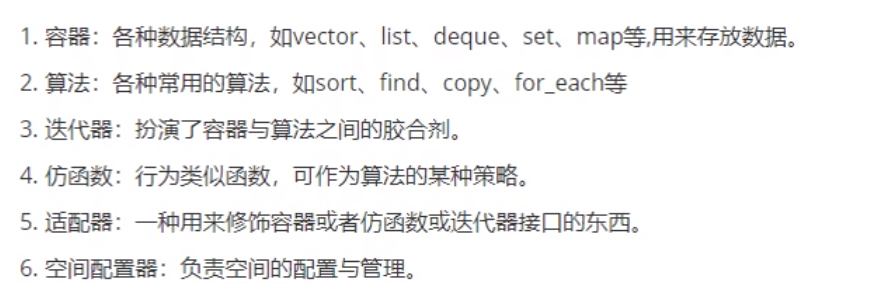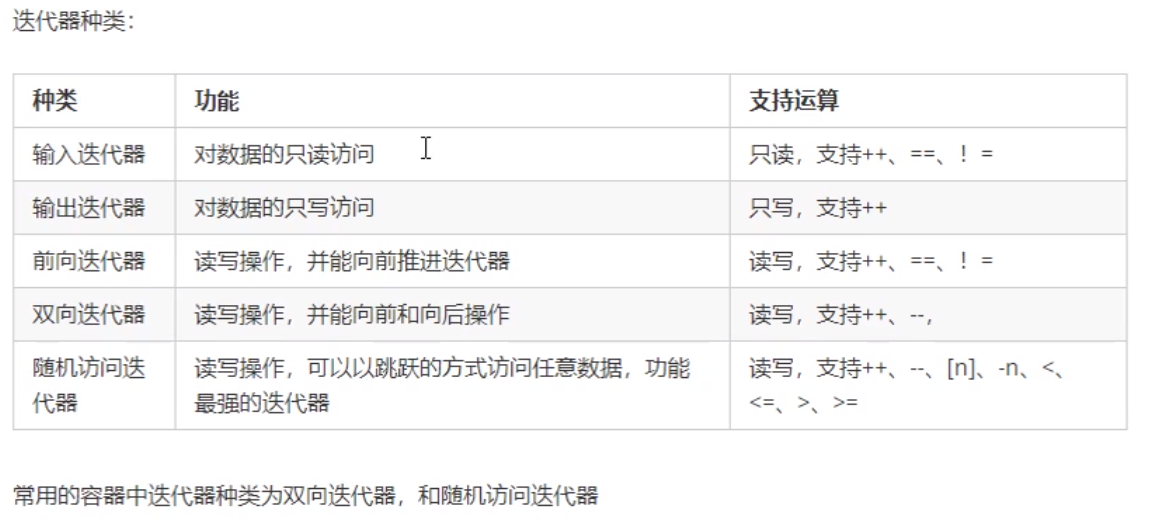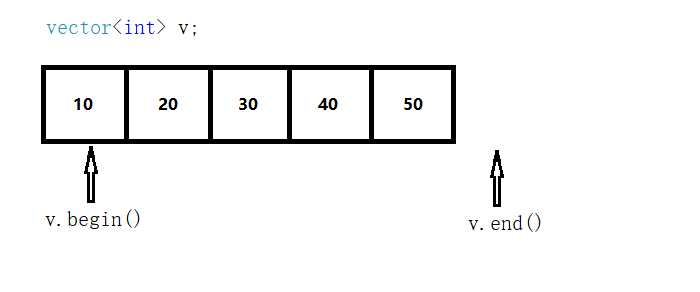C++学习 --- STL初识
1、STL的诞生

c++的三种特性:封装,继承,多态
封装:相似的东西封装成一个类,提高复用性
继承:子类继承父类中的属性,行为,提高代码复用性
多态:一个函数名称有多个接口,父类指针指向子类对象,调用同一个接口时,由于对象的不同会产生不同的形态,提高了复用性。
2、STL基本概念

3、STL六大组件


仿函数:小括号重载,类似于函数。
4、STL中容器、算法、迭代器



算法要通过迭代器才可以访问容器中的元素。

5、容器算法迭代器初识

5.1、vector存放内置数据类型

可参考 上一节通用数组类,MyArray案例来理解vector。
#include <iostream> using namespace std; #include <vector> //标准算法的头文件 #include <algorithm> //vector 容器 存放内置数据类型 void myPrint(int val) { cout << val << endl; } void test01() { //创建了一个vector的容器 vector<int> v; //像容器中插入数据 v.push_back(10); v.push_back(20); v.push_back(30); v.push_back(40); v.push_back(50); //第一种遍历方式 cout << "第一种遍历方式:" << endl; //通过迭代器访问容器中的数据 //起始迭代器 指向容器中第一个元素 vector<int>::iterator itBegin = v.begin(); //结束迭代器 指向容器中最后一个元素的下一个位置 vector<int>::iterator itEnd = v.end(); while (itBegin != itEnd) { cout << *itBegin << endl; itBegin++; } //第二种遍历方式 cout << "第二种遍历方式:" << endl; for (vector<int>::iterator it = v.begin(); it != v.end(); it++) { cout << *it << endl; } //第三种遍历方式 利用STL提供遍历算法 //第三个参数 myPrint 回调函数,在for_each遍历期间调用。 cout << "第三种遍历方式:" << endl; for_each(v.begin(), v.end(), myPrint); } int main() { test01(); system("pause"); return 0; }

起始迭代器 指向容器中第一个元素,结束迭代器 指向容器中最后一个元素的下一个位置。
迭代器使用非常类似指针,需要解引用可访问到数据。
5.2、vector存放自定义类型数据
#include <iostream> #include <string> #include <vector> using namespace std; //vector 容器中存放自定义数据类型 class Person { public: Person(string name, int age) { this->m_Name = name; this->m_Age = age; } string m_Name; int m_Age; }; void test01() { vector<Person> v; Person p1("aaa",10); Person p2("bbb",20); Person p3("ccc",30); Person p4("ddd",40); Person p5("eee",50); //像容器中添加数据 v.push_back(p1); v.push_back(p2); v.push_back(p3); v.push_back(p4); v.push_back(p5); cout << "存放自定义数据类型:" << endl; //遍历容器中的数据 for (vector<Person>::iterator it = v.begin(); it != v.end(); it++) { //cout << "姓名:" << (*it).m_Name << "\t年龄:" << (*it).m_Age << endl; cout << "姓名:" << it->m_Name << "\t年龄:" << it->m_Age << endl; } } //存放自定义数据类型的指针 void test02() { vector<Person *> v; Person p1("aaa", 10); Person p2("bbb", 10); Person p3("ccc", 10); Person p4("ddd", 10); Person p5("eee", 10); //像容器中添加数据 v.push_back(&p1); v.push_back(&p2); v.push_back(&p3); v.push_back(&p4); v.push_back(&p5); //遍历容器中的数据 cout << "存放自定义数据类型的指针:" << endl; for (vector<Person *>::iterator it = v.begin(); it != v.end(); it++) { cout << "姓名:" << (*it)->m_Name << "\t年龄:" << (*it)->m_Age << endl; //cout << "姓名:" << it->m_Name << "\t年龄:" << it->m_Age << endl; } } int main() { test01(); test02(); system("pause"); return 0; }
每个容器都有自己专属的迭代器 vector<Person>::iterator it; vector<Person *>::iterator itp;
解出的类型就是这个人容器中的类型 (*it) <==> Person; ( *itp) <==> Person *
5.3、vector容器嵌套容器
#include <iostream> #include <vector> using namespace std; //vector容器嵌套容器 void test01() { vector< vector<int> > v; //创建小容器 vector<int> v1; vector<int> v2; vector<int> v3; vector<int> v4; //像小容器中添加数据 for (int i = 0; i < 4; i++) { v1.push_back(i + 1); v2.push_back(i + 2); v3.push_back(i + 3); v4.push_back(i + 4); } //将小容器插入到大的容器中 v.push_back(v1); v.push_back(v2); v.push_back(v3); v.push_back(v4); //通过大容器把所有的数据遍历一遍 for (vector< vector<int>>::iterator it = v.begin(); it != v.end(); it++) { for (vector<int>::iterator vit = (*it).begin(); vit != (*it).end(); vit++) { cout << *vit << " "; } cout << endl; } } int main() { test01(); system("pause"); return 0; }



